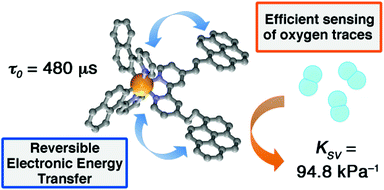High performance optical oxygen sensors based on iridium complexes exhibiting interchromophore energy shuttling†
Abstract
A doubly pyrene-grafted bis-cyclometallated iridium complex with engineered electronically excited states demonstrates reversible electronic energy transfer between adjacent chromophores giving rise to extremely long-lived red luminescence in solution (τ = 480 μs). Time-resolved spectroscopic studies afforded determination of pertinent photophysical parameters including rates of energy transfer and energy distribution between constituent chromophores in the equilibrated excited molecule (ca. 98% on the organic chromophores). Incorporation into a nanostructured metal–oxide matrix (AP200/19) gave highly sensitive O2 sensing films, as the detection sensitivity was 200–300% higher than with the commonly used PtTFPP and approaches the sensitivity of the best O2-sensing dyes reported to date.

- This article is part of the themed collection: Analyst Recent Open Access Articles


 Please wait while we load your content...
Please wait while we load your content...